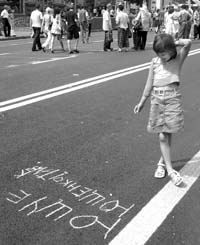On June 31, 250 leaders of Ukrainian youth organizations gathered in Kharkiv for a three-day All-Ukrainian Youth Summit held under UN auspices with the goal of influencing the government’s youth policy. On June 26 young Ukrainians joined the rest of the world in celebrating World Youth Day. According to international standards, some 11 million Ukrainians aged 14 to 24 could rightfully celebrate this holiday. Meanwhile, in Ukraine even individuals in the under-35 group have official youth status, whereas teens older than 14 but younger than 18 can boast a dual status as the youngest representatives of youth and the oldest children. Pedagogues call this a transitional age between childhood and adolescence, or the awkward age. Statistically, 4 million Ukrainians fall into this age bracket. Educators believe that these children need the greatest amount of attention. Whereas in the past most teenagers joined community organizations, now it has become a question of choice. Pedagogues view this as the root cause of countless problems.
Many experts consider the children’s movement part of the youth movement. After all, some youth organizations admit teenagers, while some children’s organizations admit adolescents younger than 18. Incidentally, historians have found records of the earliest Ukrainian youth movements dating from the 16th-18th centuries (youth fraternities of church associations and the novitiate with the Brazilian Order of the Uniate Church). Young people became more socially active in the 18th and 19th centuries, but since the mid-1920s in the USSR and the 1940s in Western Ukraine there were only two organizations: the Pioneers and the Komsomol Young Communist League, to which the regime delegated the state’s functions of raising the young generation in the spirit of dedication to communist ideals. In the late 1980s the foundations of these organizations began to disintegrate and they were replaced by various other associations. After independence Ukraine developed a legislative groundwork for the development of youth and children’s movements.
Ukraine currently has 10,000 children’s and 114 youth organizations. Experts say, however, that these organizations lack a systematic approach in their efforts, which are often restricted to staging individual activities with no regard for the holistic development of the child’s personality. According to Rayisa Okhrimchuk, doctoral candidate in psychology and chairperson of the Children’s Associations’ Laboratory at the Ukrainian Academy of Psychological Sciences’ institute devoted to problems of bringing up children and adolescents, “Studies suggest that children’s organizations in Ukraine are not fulfilling their main function: socializing children. Often they focus their efforts on a single aspect of socialization. Depending on their goals, all children’s associations can be divided into three groups: those aimed at developing the personality, developing cognitive skills, and focusing on a certain educational direction.”
It is always interesting for a child to find a group where s/he can say “we” or make friends and engage in a group activity. Community organizations provide such an opportunity. But for some reason not all young Ukrainians take advantage of this opportunity. At the same time, experts point out that because of inadequate funding children’s organizations often seek aid from political forces, thereby becoming ideologically dependent.
Studies suggest that funding tops the list of problems facing children’s organizations. Organizations with a membership in excess of 1,000 do not collect membership fees. Commercial structures and individuals invest in big organizations, believing that quantity means quality. The same is true of subsidies from the local authorities. Organizations with fewer members are losing financial support from them as well.
Rayisa Okhrimchuk is convinced that training adult leaders for the organization of the children’s movement is a serious task. It would be worthwhile creating a structure in Ukraine that would be similar to the House of Community Organizations in Russia, where different civic organizations exchange information.
Pedagogues say that community organizations are doors through which children enter society. They are like small countries in which children have everything that is present in the adult world, but act in these countries under the protection of adults. However, Ukraine is facing a shortage of professionals with experience of working in such informal children’s organizations.







